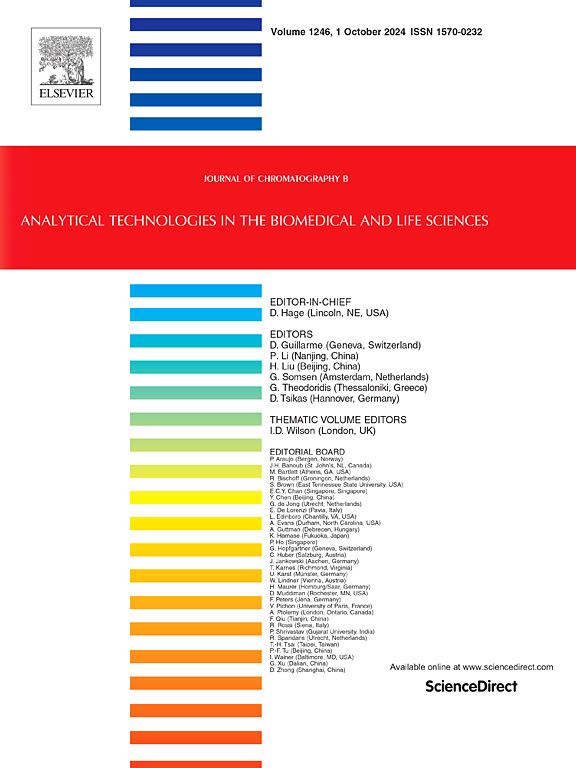Accurate determination of fluoxetine and its metabolites in Mediterranean mussel organs based on solid phase extraction clean-up and HPLC-HRMS
IF 2.8
3区 医学
Q2 BIOCHEMICAL RESEARCH METHODS
引用次数: 0
Abstract
Fluoxetine, a widely prescribed antidepressant, is frequently detected in marine environments, exposing marine invertebrates to this emerging contaminant. Due to its potential to bioaccumulate and undergo biotransformation, it is essential to quantify both the parent compound and its metabolites for accurate risk assessment. Furthermore, tissue-specific measurements are crucial for identifying organ-specific accumulation that may cause localized toxic effects. An analytical method was then developed to quantify fluoxetine and three of its metabolites in individual mussel tissues (soft tissues, gills, digestive glands) using a minimal sample size (40 or 400 mg). Four solid-phase extraction sorbents were evaluated: MCX, HLB, C18, and Phree phospholipid removal. The Phree sorbent was selected as the optimal cleanup method. Further optimization involved testing two extraction solvents (acetonitrile and methanol) and two extraction techniques: ultrasonic-assisted extraction and bead-based extraction. Identification and quantification were performed using HPLC-Orbitrap-MS, relying on accurate mass measurements of selected MS/MS fragments. The method demonstrated satisfactory Method Quantification Limits (MQL) for fluoxetine (1.2, 10.5, and 10.4 μg/kg dw) and its main metabolite, norfluoxetine (5.1, 25.6, and 24.3 μg/kg dw) in soft tissues, digestive glands, and gills, respectively. These MQL values align with literature data, especially given the low sample size and the expression of concentrations on a dry weight basis. The final method allows the sensitive quantification of fluoxetine and its metabolites from small volumes, facilitating the assessment of their distribution across three target organs. These advancements support the development of toxicokinetic/toxicodynamic (TK/TD) models, contributing to environmental risk assessment of emerging contaminants.
固相萃取净化- HPLC-HRMS法精确测定地中海贻贝器官中氟西汀及其代谢物
氟西汀是一种广泛使用的抗抑郁药,经常在海洋环境中检测到,使海洋无脊椎动物暴露于这种新出现的污染物中。由于其具有生物积累和生物转化的潜力,因此对母体化合物及其代谢物进行量化以进行准确的风险评估至关重要。此外,组织特异性测量对于识别可能导致局部毒性作用的器官特异性积累至关重要。然后开发了一种分析方法,使用最小样本量(40或400毫克)对单个贻贝组织(软组织、鳃、消化腺)中的氟西汀及其三种代谢物进行定量。评估了四种固相萃取吸附剂:MCX, HLB, C18和Phree磷脂去除。选择Phree吸附剂作为最佳的清除方法。进一步的优化包括测试两种提取溶剂(乙腈和甲醇)和两种提取技术:超声波辅助提取和珠状提取。使用HPLC-Orbitrap-MS进行鉴定和定量,依赖于所选MS/MS片段的精确质量测量。该方法在软组织、消化腺和鳃中分别检测到氟西汀(1.2、10.5和10.4 μg/kg dw)及其主要代谢物去甲氟西汀(5.1、25.6和24.3 μg/kg dw)的定量限(MQL)满意。这些MQL值与文献数据一致,特别是考虑到低样本量和以干重为基础的浓度表达。最后一种方法允许小体积的氟西汀及其代谢物的敏感定量,便于评估它们在三个目标器官中的分布。这些进展支持毒物动力学/毒物动力学(TK/TD)模型的发展,有助于对新出现的污染物进行环境风险评估。
本文章由计算机程序翻译,如有差异,请以英文原文为准。
求助全文
约1分钟内获得全文
求助全文
来源期刊

Journal of Chromatography B
医学-分析化学
CiteScore
5.60
自引率
3.30%
发文量
306
审稿时长
44 days
期刊介绍:
The Journal of Chromatography B publishes papers on developments in separation science relevant to biology and biomedical research including both fundamental advances and applications. Analytical techniques which may be considered include the various facets of chromatography, electrophoresis and related methods, affinity and immunoaffinity-based methodologies, hyphenated and other multi-dimensional techniques, and microanalytical approaches. The journal also considers articles reporting developments in sample preparation, detection techniques including mass spectrometry, and data handling and analysis.
Developments related to preparative separations for the isolation and purification of components of biological systems may be published, including chromatographic and electrophoretic methods, affinity separations, field flow fractionation and other preparative approaches.
Applications to the analysis of biological systems and samples will be considered when the analytical science contains a significant element of novelty, e.g. a new approach to the separation of a compound, novel combination of analytical techniques, or significantly improved analytical performance.
 求助内容:
求助内容: 应助结果提醒方式:
应助结果提醒方式:


